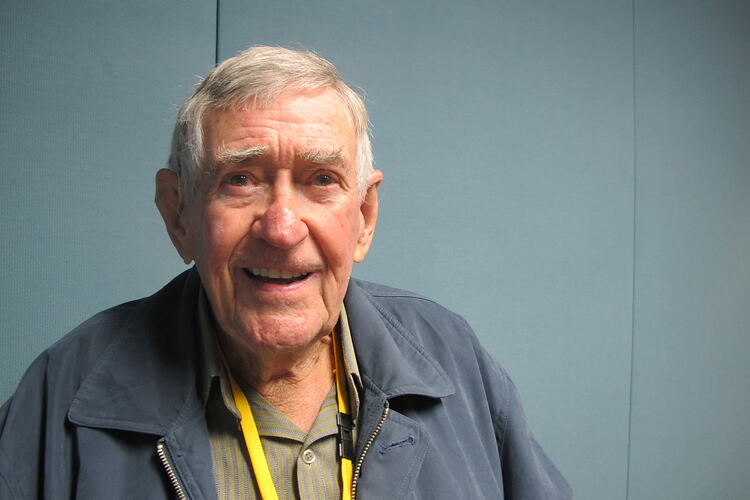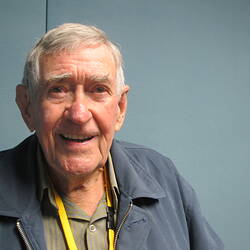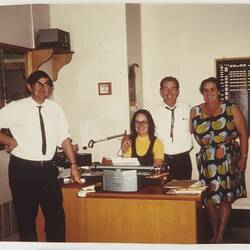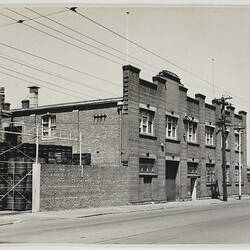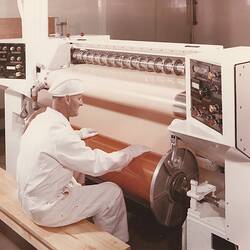Summary
Maintenance engineer and production planner, 1951- 1984.
Jim Healy, Kodak Australasia Pty Ltd: Maintenance Engineer and Production Planner, 1951 - 1984
After completing his apprenticeship in metal machining, Jim Healy worked in several jobs reconditioning car engines. In 1951 he commenced employment as a maintenance engineer at Kodak Australasia's Abbotsford workshops. His career with Kodak lasted 33 years.
First impressions
Jim recalls his first impressions of the Kodak factory at Abbotsford:
'I was very surprised actually, because I worked in other small factories. They sort of took me up and gave me a lecture on safety and health, and I'd never been used to anything like that. Virtually just a factory floor before that. Yes, it had medical centre there and things like that. And they looked after you, probably social wise and health wise ...'
Kodak was going through a period of post-war expansion in the 1950s and the company was outgrowing its Abbotsford site. Jim's first job was to assist with the development of a new processing and printing works for black and white photographs in the former Barnes honey property in Burnley. Jim made the brackets and stands to hold the developing tanks and other equipment.
In the maintenance workshops
A few months later Jim returned to the main factory site at Abbotsford, where he worked in the machine shop as a member of the large team of tradesmen responsible for maintaining Kodak's manufacturing plant. Routine work included maintaining guillotines and repairing pumps, plus the annual overhaul of Kodak's machinery when production closed for the Christmas break.
The workshops also constructed much of the equipment that Kodak used for manufacturing photographic products. Jim remembers making a new slitting machine for cutting the large rolls of film after they had been coated with light sensitive emulsion. This big project involved all the tradesmen in the workshops.
The film coating machines operated in a darkened room because the sensitised film could not be exposed to light. Safe lighting was provided in the work environment at a colour and low level of intensity that would not harm the film being manufactured. Jim remembers carrying out urgent repair work with only a small red safe light to see by. He had first gained experience maintaining the machines in the daylight.
When Kodak moved to a new factory in Coburg in the early 1960s, Jim was happy to transfer because he had bought a house in a nearby suburb.
Wages and other benefits
Jim found the wages were better at Kodak than the other small firms he had worked for, and really appreciated the annual bonus paid to all employees based on a percentage of their wages. The amount depended on the profits for the year. Jim remembers that the bonus was 'very handy for Christmas and the holidays'.
Jim purchased his house with a loan from one of the Yarra Grange housing co-operatives sponsored by Kodak. He remembers that loan repayments could not exceed twenty five percent of the employee's wages:
'And one of the plumbers or sheet metal workers got a house and he just exceeded that twenty five percent, so we all got called to a meeting and asked if he could get sixpence a week extra to just bring him to the twenty five. If he's got that no one's going to complain, 'cause he's got it. So we all agreed to it. So he got the little sixpence a week extra.
Production planning
In the 1970s Kodak needed to improve efficiencies in production in order to remain profitable in an increasingly competitive market. Jim became a production planner with the role of examining work practices in the plastics and metal production department. His new job included running time and motion studies; for example watching the assembly of cameras:
'. about thirty girls assembling a camera, and each one's got to do a little bit, and you had to work out from the start to the end of the camera, what they do and match up how long it takes, and get an even flow of work ... Not so much to speed it up, but a more efficient way of doing things - cut down double handling.'
Jim would devise little tools to assist in the process.
The 1980s was a time of rationalization for Kodak Australasia, and a number of long-serving employees, including Jim, were asked to take early retirement. [Beale p.177] Jim was not ready to retire when he left Kodak in 1984, and he found temporary, part-time work for a few years.
'I've got no regrets. I raised my family at Kodak, they paid for it, and I got my house through them. And, oh it was a good place to work. They looked after you.'
References
Beale, Nigel, 'The History of Kodak in Australia', 1983.
HT 36792 - Oral History Interview with Jim Healy, interviewed by Lesley Alves 17 March 2014.
More Information
-
Keywords
-
Authors
-
Article types
